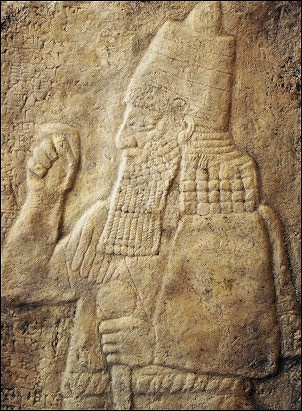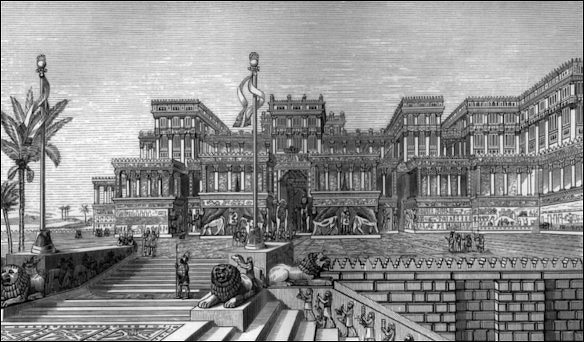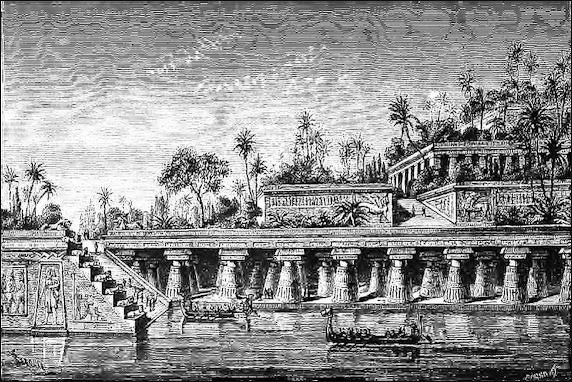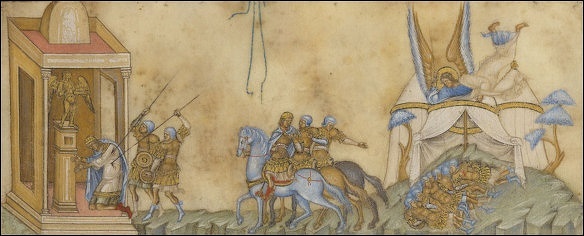SENNACHERIB

Sennacherib
Sennacherib (705 to 681 B.C.) expanded Ninevah, built three massive palaces, one with two miles of sculptured inner walls, and led a number of military campaigns. He destroyed Babylon, conquered Sidon in Phoenicia and invaded Judia and led attacks in the Persian Gulf and Mediterranean. His attack on Tyre was thwarted.
Sennacherib was the son of Sargon II. He is best known for his unsuccessful siege of Jerusalem in 701 B.C. Sennacherib advanced into Egypt in 701 B.C. but was stopped by a Nubian army. After the failed siege to Jerusalem he returned to Assyria in disgrace and was murdered 18 years later, reportedly by his own sons. He was succeeded by Esarhaddon (681-668 B.C.) of Assyrian sacked Memphis in Egypt in 671 B.C. and conquered lower Egypt.
Aaron Skaist wrote in the Encyclopaedia Judaica: The accession of Sennacherib (704–681 B.C.) marked a new phase in Assyrian imperialism. No longer did the Assyrian army march annually towards new conquests. Only eight campaigns occupied the 24 years of the new monarch, besides two conducted by his generals. Assyrian power was approaching the natural limits of which it was capable, and new thrusts into distant border regions were probably defensive in inspiration. Although the warlike ideals of their forebears continued to color the records of the later Sargonid kings, the impression of sustained militarism that they create is an exaggerated one. The real spirit of the time is revealed, on the one hand, by such marvels of civil engineering as Sennacherib's aqueduct at Jerwan and, on the other, by the greatly increased attention to administrative matters reflected in the growing amount of royal correspondence. Literature and learning too came into their own, and the vast library assembled by Ashurbanipal at Nineveh is only the most dramatic expression of the new leisure. [Source: Aaron Skaist, Encyclopaedia Judaica, 2005, Encyclopedia.com]
RECOMMENDED BOOKS:
“Sennacherib, King of Assyria” by Josette Elayi (2018) Amazon.com;
“The Annals of Sennacherib” by Daniel David Luckenbil (1924) Amazon.com;
“The Royal Inscriptions of Sennacherib, King of Assyria (704-681 BC)” by Sennacherib) Amazon.com;
“Sennacherib's "Palace without Rival" at Nineveh” by John Malcolm Russell (1992) Amazon.com;
“Sennacherib at the Gates of Jerusalem: Story, History and Historiography” by Isaac Kalimi and Seth Richardson (2014) Amazon.com;
“Siege: The Story of Hezekiah and Sennacherib” by Thurman C Petty (1980) Amazon.com;
“Reflections of Empire in Isaiah 1-39: Responses to Assyrian Ideology” by Shawn Zelig Aster (2017) Amazon.com;
“A History of the Jewish People During the Babylonian, Persian, and Greek Periods”by Charles Foster Kent Amazon.com ;
“The Kings and Prophets of Israel and Judah: From the Division of the Kingdom to the Babylonian Exile (Classic Reprint)” by John Foster Mitchel Amazon.com ;
“Oxford Companion to the Bible” by Bruce M. Metzger and Michael David Coogan Amazon.com ;
“Assyria: The Rise and Fall of the World's First Empire” by Eckart Frahm (2023) Amazon.com;
“Assyrian Empire: A History from Beginning to End” by History Hourly (2019) Amazon.com;
“A Companion to Assyria” by Eckart Frahm (2017) Amazon.com;
“Ancient Assyria: A Very Short Introduction” by Karen Radner (2015) Amazon.com;
“The Might That Was Assyria” by H. W. F. Saggs (1984) Amazon.com;
“Ancient Assyria” by James Baikie (2022) Amazon.com;
“Ancient Mesopotamia: an Enthralling Overview of Mesopotamian History (2022) Amazon.com;
“Mesopotamia: a Captivating Guide (2019) Amazon.com;
“A History of the Ancient Near East” by Marc Van De Mieroop (2003) Amazon.com;
Sennacherib Military Campaigns
Morris Jastrow said: “Sennacherib (705-681 B.C.) determines upon a more aggressive policy, and at last in 689 B.C., Babylon is taken and mercilessly destroyed. Sennacherib boasts of the thoroughness with which he carried out the work of destruction. He pillaged the city of its treasures. He besieged and captured all the larger cities of the south—Sippar, Uruk, Cuthah, Kish, and Nippur—and when, a few years later, the south organised another revolt, the king, to show his power, put Babylon under water, and thus obliterated almost all vestiges of the past. [Source: Morris Jastrow, Lectures more than ten years after publishing his book “Aspects of Religious Belief and Practice in Babylonia and Assyria” 1911]
The excavations at Babylon carried on by the German expedition show how truthfully Sennacherib described his work of destruction; few traces of the older Babylon have been revealed by the spade of the explorer. What is found dates chiefly from the time of the Neo-Babylonian dynasty, and particularly from the days of Nebuchadnezzar, who, as the restorer of the past glory of the capital, is justified in boasting, as in the Book of Daniel, “Is not this great Babylon that I have built!” Babylonia, however, had the satisfaction of surviving Assyria. By a combination of hordes from the north with Medes of the south-east,—the latter abetted no doubt by Babylonia,—Nineveh is taken in 606 B.C., and the haughty Assyrian power is crushed for ever.

Sennacherib
The Assyrian Army was the most effective force of its time. It was divided mostly into three different categories: 1) Infantry, which included both close-combat troops using spears, and archers, and hired mercenary slingers (stone throwers); 2) cavalry among the finest in the ancient Middle East and included both close-combat cavalry units with spears and mounted archers; and chariots, primarily used in regular land engagements not in sieges. The infantry was highly trained and worked alongside military engineers in order to breach sieges. Mounted archers could be utilized for their agility of the horses alongside long-range attacks. [Source: Wikipedia]
Aaron Skaist wrote in the Encyclopaedia Judaica: The new Pax Assyriaca was, of course, not unbroken by military campaigns.Sennacherib's unsuccessful siege of Jerusalem in 701 is well known from both the Assyrian and biblical accounts (II Kings 18:13–19:37; Isa. 36–37). His generals campaigned against Cilicia and Anatolia (696–695 B.C.), while his successor Esarhaddon (680–669 B.C.) is perhaps most famous for his conquest of Egypt. Esarhaddon had succeeded to the throne in the troubled times following his father's assassination (cf. II Kings 19:37; Isa. 37:38), and was determined to secure a smoother succession for his own sons. [Source: Aaron Skaist, Encyclopaedia Judaica, 2005, Encyclopedia.com]
The vassals of the empire were therefore forced to swear to abide by his arrangements, and the treaties to this effect, excavated at Calah, have proved a new key to the understanding of Deuteronomy. The king's planning at first bore fruit, and for 17 years his designated successors ruled the empire side by side, Ashurbanipal from Nineveh and Shamash-shum-uk-îm from Babylon. However, in 652, war broke out between the two brothers. After four years of bloody warfare, Ashurbanipal emerged victorious, but at a heavy price. The Pax Assyriaca had been irreparably broken, and the period of Assyrian greatness was over. The last 40 years of Assyrian history were marked by constant warfare in which Assyria, in spite of occasional successes, was on the defensive. At the same time the basis for a Babylonian resurgence was being laid even before the final Assyrian demise.
Sennacherib Campaign in 701 B.C.
Around 700 B.C. several kingdoms in the Levant ceased to pay taxes to the Assyrian king Senncharib. In retribution, he initiated a campaign to re-subjugate the rebelling kingdoms, among them the Kingdom of Judah. After defeating the rebels of Ekron in Philistia, Sennacharib set out to conquer Judah and, on his way to Jerusalem, came across Lachish: the second most important of the Jewish cities. [Source: Wikipedia]
Sennacherib's Prism — a hexagonal clay prism that records the campaigns of Sennacherib written in the Akkadian language in 689 B.C. — details the events of Sennacherib's campaign against Judah, was discovered in the ruins of Nineveh in 1830, and is now stored at the Oriental Institute in Chicago. The Prism dates from about 690 B.C., and its account is taken from an earlier cuneiform inscription dating to 700 B.C..
Sennacherib" Unsuccessful Siege of Jerusalem and the Angel of the Lord

Sennacherib is probably remembered most for his unsuccessful siege of Jerusalem in 701 B.C. Although Sennacherib was successful in conquering Lachish and many other Judahite cities and towns, he did not conquer Jerusalem. When the leader of Jerusalem Hezekiah said he was going to seek help from the Egyptians, the Assyrians, as recorded in the Bible’s Book of Kings replied: “Thou trustest upon the staff of this bruised reed [of] Egypt , in which if a man leans, it will go into his hands and pierce it: So is Pharaoh king of Egypt unto all that trust in him.”
The siege was cut short, according to the Bible, by intervention by angels. The account of Sennacherib’s siege of Jerusalem was written on six-sided clay book. An inscription on a statue found in the doorway of Sennacherib’s throne room recounts a story of Biblical story of bribery, the first known independent written account corresponding to a story in the Bible.
From The Hebrew Bible, 2 Chronicles 32: “But after he had proved his [Hezekiah's] fidelity by such deeds, Sennacherib, king of Assyria, came. He invaded Judah, besieged the fortified cities, and proposed to take them by storm. . . .His officials said still more against the Lord God and against his servant Hezekiah, for he had written letters to deride the Lord, the God of Israel. . . They spoke of the God of Israel as though he were one of the gods of the other peoples of the earth, a work of human hands. But because of this, King Hezekiah and the prophet Isaiah, son of Amos, prayed and called out to him. Then the Lord sent an angel, who destroyed every valiant warrior, leader and commander in the camp of the Assyrian king, so that he had to return shamefaced to his own country. And when he entered the temple of his own god, some of his own offspring struck him down there with the sword.
The reasons why the Assyrians couldn't conquer Jerusalem debated, but it is known that a short time later, Judah was once again paying tribute to the Assyrian Empire. After Sennacherib returned to Nineveh he was murdered by his own sons.
See Separate Article: SENNACHERIB'S ATTACK ON JUDAH AND THE SIEGE OF JERUSALEM africame.factsanddetails.com ; CONQUEST OF THE JEWISH KINGDOMS BY ASSYRIA africame.factsanddetails.com
Isaiah Prophesies Sennacherib’s Fall
Isaiah 37:20 Then Isaiah son of Amoz sent a message to Hezekiah: “This is what the Lord, the God of Israel, says: I have heard your prayer concerning Sennacherib king of Assyria. 21 This is the word that the Lord has spoken against him:
30 Once more a remnant of the kingdom of Judah
will take root below and bear fruit above.
31 For out of Jerusalem will come a remnant,
and out of Mount Zion a band of survivors.
“The zeal of the Lord Almighty will accomplish this.
32 “Therefore this is what the Lord says concerning the king of Assyria:
[Source: Bible Gateway]
“‘He will not enter this city
or shoot an arrow here.
He will not come before it with shield
or build a siege ramp against it.
33 By the way that he came he will return;
he will not enter this city,
declares the Lord.
34 I will defend this city and save it,
for my sake and for the sake of David my servant.’”
35 That night the angel of the Lord went out and put to death a hundred and eighty-five thousand in the Assyrian camp. When the people got up the next morning—there were all the dead bodies! 36 So Sennacherib king of Assyria broke camp and withdrew. He returned to Nineveh and stayed there.
37 One day, while he was worshiping in the temple of his god Nisrok, his sons Adrammelek and Sharezer killed him with the sword, and they escaped to the land of Ararat. And Esarhaddon his son succeeded him as king.

Palace of Sennacherib
Destruction of Sennacherib by Lord Byron
Destruction of Sennacherib by Lord Byron (George Gordon, 1813) reads:
The Assyrian came down like the wolf on the fold,
And his cohorts were gleaming in purple and gold;
And the sheen of their spears was like stars on the sea,
When the blue wave rolls nightly on deep Galilee.
Like the leaves of the forest when Summer is green,
That host with their banners at sunset were seen:
Like the leaves of the forest when Autumn hath blown,
That host on the morrow lay withered and strown.
For the Angel of Death spread his wings on the blast,
And breathed in the face of the foe as he passed;
And the eyes of the sleepers waxed deadly and chill,
And their hearts but once heaved, and for ever grew still!
And there lay the steed with his nostril all wide,
But through it there rolled not the breath of his pride;
And the foam of his gasping lay white on the turf,
And cold as the spray of the rock-beating surf.
And there lay the rider distorted and pale,
With the dew on his brow, and the rust on his mail:
And the tents were all silent, the banners alone,
The lances unlifted, the trumpet unblown.
And the widows of Ashur are loud in their wail,
And the idols are broke in the temple of Baal;
And the might of the Gentile, unsmote by the sword,
Hath melted like snow in the glance of the Lord!

Hanging Gardens
Sennacherib, not Nebuchadnezzar, the Builder of the Hanging Gardens?
The bas-relief from Sennacherib’s palace in Nineveh taht portray the hanging gardens appears to suggest that he — not Nebuchadnezzar — was the builder of the hanging gardens. “It’s taken many years to find the evidence to demonstrate that the gardens and associated system of aqueducts and canals were built by Sennacherib at Nineveh and not by Nebuchadnezzar in Babylon. For the first time it can be shown that the Hanging Garden really did exist” said Dr. Dalley.” =
David Keys wrote in The Independent: “The newly revealed builder of the Hanging Gardens,Sennacherib of Assyria - and Nebuchadnezzar of Babylon who was traditionally associated with them - were both aggressive military leaders. Sennacherib’s campaign against Jerusalem was immortalized some 2500 years later in a poem by Lord Byron describing how “the Assyrians came down like a wolf on the fold,” his cohorts “gleaming in purple and gold.” [Source: David Keys, The Independent, May 6, 2013 =]
“Both were also notorious for destroying iconic religious buildings. Nebuchadnezzar of Babylon destroyed Solomon’s Temple in Jerusalem and according to one much later tradition was temporarily turned into a beast for his sins against God. Sennacherib of Assyria destroyed the great temples of Babylon, an act which was said to have shocked the Mesopotamian world. Indeed tradition holds that when he was later murdered by two of his sons, it was divine retribution for his destruction of those temples. =
“Bizarrely it may be that the Hanging Gardens were the first of the seven ‘wonders’ of the world to be so described – for Sennacherib himself referred to his palace gardens, built in around 700BC or shortly after, as “a wonder for all the peoples”. It’s only now however that the new research has finally revealed that his palace gardens were indeed one of the Seven Wonders of the Ancient World. Some historians have thought that the Hanging Gardens may even have been purely legendary. The new research finally demonstrates that they really did exist. =

Death of Sennacherib
Image Sources: Wikimedia Commons
Text Sources: Internet Ancient History Sourcebook: Mesopotamia sourcebooks.fordham.edu , National Geographic, Smithsonian magazine, especially Merle Severy, National Geographic, May 1991 and Marion Steinmann, Smithsonian, December 1988, New York Times, Washington Post, Los Angeles Times, Discover magazine, Times of London, Natural History magazine, Archaeology magazine, The New Yorker, BBC, Encyclopædia Britannica, Metropolitan Museum of Art, Time, Newsweek, Wikipedia, Reuters, Associated Press, The Guardian, AFP, Lonely Planet Guides, “World Religions” edited by Geoffrey Parrinder (Facts on File Publications, New York); “History of Warfare” by John Keegan (Vintage Books); “History of Art” by H.W. Janson Prentice Hall, Englewood Cliffs, N.J.), Compton’s Encyclopedia and various books and other publications.
Last updated June 2024
